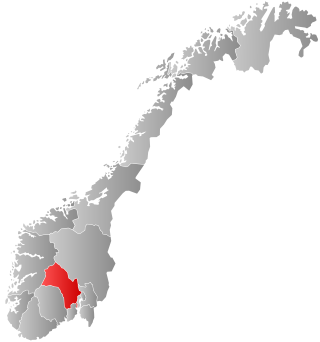
Buskerud is a county and a current electoral district in Norway, bordering Akershus, Oslo, Innlandet, Vestland, Telemark and Vestfold. The region extends from the Oslofjord and Drammensfjorden in the southeast to Hardangervidda mountain range in the northwest. The county administration was in modern times located in Drammen. Buskerud was merged with Akershus and Østfold into the newly created Viken County on 1 January 2020. On 23 February 2022, the Viken County Council voted in a 49 against 38 decision to submit an application to the Norwegian government for a county demerger. Due to this, Buskerud was re-established in 2024.

Hole is a municipality in Buskerud county, Norway. It is part of the traditional region of Ringerike. The administrative centre of the municipality is the village of Vik. Hole is located around lake Tyrifjorden and extends to the woodland around Oslo. The soil is fertile and suited to growing fruit, berries and other agricultural products.
Sir George Webbe Dasent, D. C. L. (1817–1896) was a British lawyer, translator of folk tales and contributor to The Times.

Hønefoss is a town and the administrative center of the municipality of Ringerike in Buskerud, Viken county, Norway. Hønefoss is an industrial center of inner Østlandet, containing several factories and other industry. As of 1 January 2022, Hønefoss had 16,547 inhabitants. Between 1852 and 1964, the town was an independent municipality.

"Three Billy Goats Gruff" is a Norwegian fairy tale collected by Peter Christen Asbjørnsen and Jørgen Moe in their Norske Folkeeventyr, first published between 1841 and 1844. It has an Aarne-Thompson type of 122E. The first version of the story in English appeared in George Webbe Dasent's translation of some of the Norske Folkeeventyr, published as Popular Tales from the Norse in 1859. The heroes of the tale are three male goats who need to outsmart a ravenous troll to cross the bridge to their feeding ground.

Peter Christen Asbjørnsen was a Norwegian writer and scholar. He and Jørgen Engebretsen Moe were collectors of Norwegian folklore. They were so closely united in their lives' work that their folk tale collections are commonly mentioned only as "Asbjørnsen and Moe".
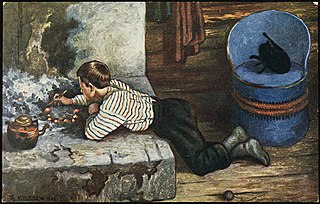
Ashlad is a main character in a number of tales collected in Asbjørnsen and Moe's Norwegian Folktales.

Norwegian Folktales is a collection of Norwegian folktales and legends by Peter Christen Asbjørnsen and Jørgen Moe. It is also known as Asbjørnsen and Moe, after the collectors.

Erik Theodor Werenskiold was a Norwegian painter and illustrator. He is especially known for his drawings for the Asbjørnsen and Moe collection of Norske Folkeeventyr, and his illustrations for the Norwegian edition of the Snorri Sturlason Heimskringla.
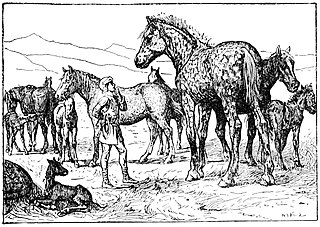
Dapplegrim is a Norwegian fairy tale collected by Peter Christen Asbjørnsen and Jørgen Moe in their Norske Folkeeventyr. Andrew Lang included it in The Red Fairy Book.
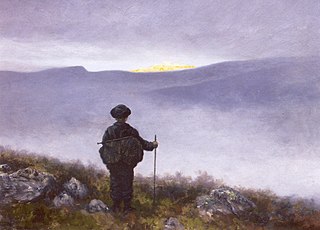
Soria Moria Castle is a Norwegian fairy tale made famous by Peter Christen Asbjørnsen and Jørgen Moe in their classical Norske Folkeeventyr. Later Andrew Lang included the story in his series of fairy tale collections in The Red Fairy Book.
"About Ash Lad, Who Stole the Troll's Silver Ducks, Coverlet, and Golden Harp" is a Norwegian folktale collected by Peter Christen Asbjørnsen and Jørgen Moe in Norwegian Folktales, translated as "Boots and the Troll" by George Webbe Dasent in 1859.

Norderhov is a former municipality located within Ringerike in Buskerud county, Norway.
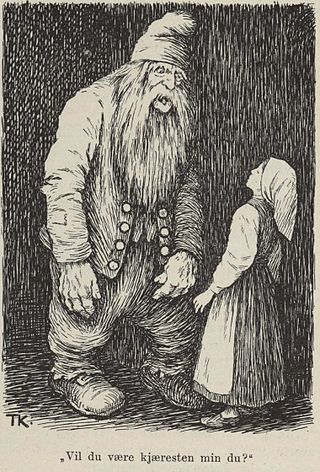
"The Old Dame and her Hen" is the English title given by Dasent to the Norwegian folk tale, Asbjørnsen and Moe’s number 35.

Gerhard August Schneider was a Norwegian artist and illustrator of folk tales.

Moltke Moe was a Norwegian folklorist.

"Boots Who Made the Princess Say, 'That's a Story'" or "The Ash Lad Who Made the Princess Say, 'You're a Liar'" is a Norwegian fairy tale collected by Peter Christen Asbjørnsen and Jørgen Moe in Norske Folkeeventyr.
Why the Bear Is Stumpy-Tailed is a Norwegian fairy tale collected by Peter Christen Asbjørnsen and Jørgen Moe in Norske Folkeeventyr.
Engebret Olsen Moe was a Norwegian Member of parliament.

"Gudbrand on the Hillside" is a Norwegian folk tale about finding the good in whatever situation one finds oneself in. It is present in many collections of folk tales including Best-Loved Folktales of the World (1982). It was one of many Norse folk tales included in Norske Folkeeventyr by Peter Christen Asbjørnsen and Jørgen Engebretsen Moe between about 1853 and 1858.




















